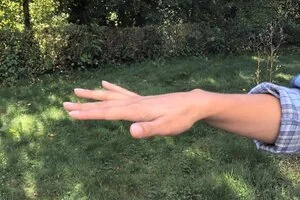Hand signs
Especially when working with big groups, hand signs can be very useful to share information without interrupting the process or take decisions swiftly.
Process
GESET: this is a useful gesture for a decision-making process (read more). Use it to signal that the proposal or what is being discussed is alright, positive, or good enough for now. The thinking behind how we use this hand sign at collaboratio is also described in more detail here. In most cultures and places, this thumbs up is understood as signalling approval and support.
Concern: this is a useful gesture for a decision-making process (read more). Use it to signal that whilst you do not have an objection, you have a concern that you think the group should consider. It therefore does not prevent the proposal for being approved, but highlights something the group should take note of. The thinking behind how we use this hand sign at collaboratio is also described in more detail here.
Objection: this is a useful gesture for a decision-making process (read more). Use it to signal that you have an objection, meaning that you see an immediate improvement or that you think proceeding would hurt the group or project. That’s right, an objection is a gift to prevent us from doing something we could easily have done better or that would do no good. The thinking behind how we use this hand sign at collaboratio is also described in more detail here.
Agreement/silent clap: In sign language, this gesture (also called jazz hands) is used to signify clapping. It is useful to signal your approval, agreement or support in a non-disturbing way during a group conversation or presentation. If you agree strongly with something that is being said, just wave a hand or two to let the speaker and group know.
I’m lost: this is a useful gesture for a training or group process (make a triangle with your hands on your forehead). Use it to signal that you are lost, i.e. not able to follow what is being said anymore. This may occur because there was too much theoretical content at once, or you lost track of the conversation. It may not mean that the group will instantly stop everything to onboard you again, but it is useful information for the trainers, speakers and group to know where you are at. If several people feel the same, perhaps the program can be adjusted or the explanation repeated, depending on the need.
Overwhelmed: this is a useful gesture for a training or group process (circle over your head with your arms). Use it to signal that you are overwhelmed, i.e. it is really too much and you cannot participate anymore. It may be because of a personal reason (for example you are experiencing a strong emotional reaction) or because everyone is talking at the same time and nothing makes sense anymore. Depending on the situation you could step out for a moment, or the group pauses and considers how to continue.
Nora Wilhelm is the Co-Founder and Catalyst of collaboratio helvetica. She has a background in youth engagement and active citizenship (European Youth Parliament) and specialised in collaboration, self-organisation, ecosystem leadership, systemic change and social innovation. Beyond facilitating multi-stakeholder processes and social innovation labs as well as promoting the Sustainable Development Goals (SDGs), she is a renowned young leader, advocate and speaker, recognised for her work by the Swiss government, UNESCO, Forbes 30 under 30 and other institutions.




